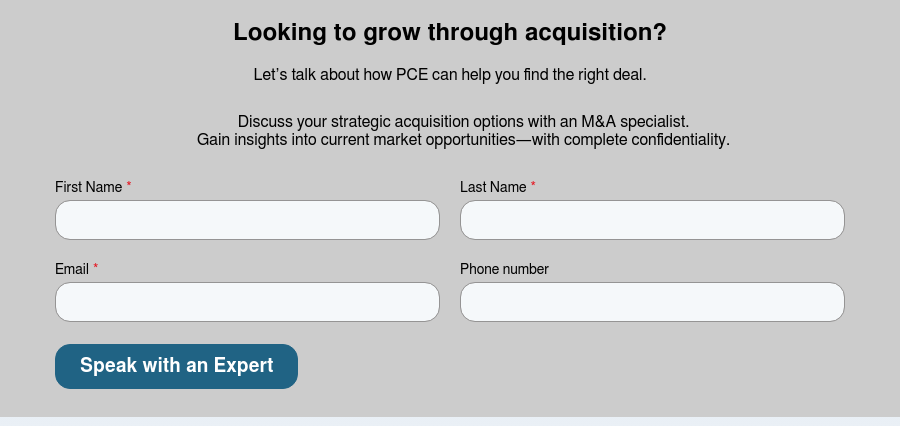Industry Trends
Largest Transactions Closed
- Target
- Buyer
- Value($mm)

For business owners and financial executives, growth is more than just a goal, a strategy, or a forecast—it’s a necessity for the survival and success of your business. Organic growth initiatives can provide innovation, control, and scalability, which are crucial to staying competitive in today’s business landscape. But if you’re seeking a fast track to meaningful growth in your business, including acquisitions in your growth plan is a must.
Read on to learn why and how your company can benefit from a well-executed acquisition strategy.
Acquiring the right business can be a powerful way to grow your organization—for example, by delivering additional market share or offering new synergies. The following are just a handful of reasons why you should develop an acquisition strategy and explore the attributes of an ideal target that will spur growth and increase the overall value of your business.
Acquiring a company that is already established in a particular geographic market allows you to quickly enter that market without the time commitment of building from scratch. Gaining access almost instantly to new customers, additional distribution channels, and increased market share is especially key if you are looking to expand operations, whether in the United States or in another country.
Increasing your market footprint through acquisition is a quick way to bring in new customers that in turn will fuel revenue and subsequent profitability. And by acquiring a competitor, you can expect to not only access their customers but also eliminate a challenger for market share.
When you acquire an established business, you also acquire its assets, intellectual property, workforce, and branding, not to mention any proprietary products, services, or know-how that can be incorporated into your company. Fresh assets that align with your strategy—plus employees who can liven up the existing business—present an opportunity to enhance and grow your capabilities.
Acquiring a complementary business can generate coveted synergies that deliver cost savings, volume discounts, and operational efficiencies, which add up to higher profits and greater long-term value. By identifying potential points of collaboration before the acquisition, you can design a post-acquisition plan to capitalize on those opportunities and track your progress—and the sooner you can realize those synergies, the more value you will create.
Whether you are a private organization or a large, publicly traded company, you want your excess cash working for you. Making acquisitions is a great use of excess cash, increasing profitability while driving overall value of the business.
In order to reap these rewards, however, you must understand how to make acquisitions according to your growth plan. Executing a successful acquisition that fully delivers the potential benefits requires that you take the following steps.
What would your ideal acquisition target look like? What is most important to the growth of your business? Will your focus be on a new product or service or a new geography? Are you looking to acquire a competitor to boost your market share and reduce competition? You may want to achieve all of the above, but ultimately you will need to determine the company’s top priorities. Narrowing down your “wish list” will prepare you to find and negotiate with potential targets in order to home in on deals that align with your overall corporate strategy.
Even a great acquisition strategy can fall short if you lack the appropriate capital to execute it. Seasoned advisors working with full-service investment banks can guide you through the various ways to raise capital—and help you determine the best option to execute your specific growth strategy. The most common sources of acquisition funding are:
Identifying the right acquisitions is a key part of the strategic growth process. Save time chasing companies that don’t share your goals and look instead for those that align with the strategy you have defined for your organization. Hiring an advisor, such as an investment banker, can help with your target search and subsequent execution of the deal.
For more information on finding acquisition targets, see Acquisition Is Your Growth Strategy, but Where Are Your Targets?.
To ensure that any potential target’s financial performance is in line with expectations, you will want to complete financial due diligence or get a quality of earnings (QofE) report done by a third party. A buy-side QofE report is usually conducted by an accounting firm that tests all the components and details around a business’s net income and EBITDA to confirm that the business is generating earnings consistent with the actual numbers—in other words, that the business is worth the price you will pay. Involving someone from your operations, legal, technical, HR, and insurance teams can help you uncover any potential liabilities or pitfalls surrounding integration and ensure a seamless flow of information throughout the process. Your due diligence team can also uncover potential post-closing synergies and develop an integration plan to handle any problems (and to track and realize any synergies) discovered during due diligence.
An experienced deal team that understands due diligence can help you avoid costly mistakes by spotting red flags in a target’s financials, operations, relationships, compliance, and legal standing. Identifying these seven issues early can prevent bigger problems later. For a deeper dive, read: Red Flags in the Acquisition Process.
As a buyer, you want to ensure that you will realize your return on investment, but you’ll need to carefully balance hard negotiations with sensitivity to a founder-owned business. Consider a collaborative approach to working with all parties beyond the closing. Understand what is non-negotiable in order for the acquisition to be accretive, as well as where you can be flexible in order to build a positive relationship with the seller. Selecting advisors who recognize and align with your goals will save you money and headaches during the process. A highly experienced mergers and acquisitions attorney who understands your needs and provides a commonsense approach is worth every penny! Also lean on your tax advisor for any tax implications of the deal structure, and work with an experienced investment banker to manage it all.
Want stronger negotiating leverage at the table? Learn how an investment banker can help you structure better terms and avoid costly pitfalls in your next acquisition. Read: Leveraging an Investment Banker for Your Acquisition Strategy.
Throughout the due diligence process and purchase agreement workflow, it is imperative to plan what the first 100 days will look like with your newly acquired business. Once the deal is inked, both sides will want to know: Now what? Are you integrating the two systems, or will the new acquisition be a stand-alone business with its own back office? Who is in charge? Is the company changing its name? Having a detailed plan for Day One and beyond—one that answers these questions and more, including which integration tasks are assigned to whom (and what the deadlines are)—will be crucial for a successful transaction. Important checklist items in those first weeks include various points around payroll, bank accounts, insurance, hiring, etc. Having a trusted team in place, ready with a solid plan and a positive attitude, is the best way to welcome the new company into your organization.
Acquisitions can be a very powerful and impactful tool to grow your business, but you’ll need to complete meticulous due diligence and perform smart negotiations while developing an optimal integration plan that puts your newly combined businesses on an upward path to success. If you are interested in exploring acquisitions for your business, PCE can deliver buy-side service offerings that help you achieve the growth you desire.

Nicole Kiriakopoulos
Nicole Kiriakopoulos is a Director at PCE, supporting clients through buy-side and sell-side M&A transactions. With nearly 20 years of experience and a focus on facility services, she has advised on more than 100 deals totaling over $1 billion in value.
Investment Banking
Chicago Office
224-520-1068 (direct)
nicolek@pcecompanies.com
Connect
224-520-1068 (direct)
407-621-2199 (fax)